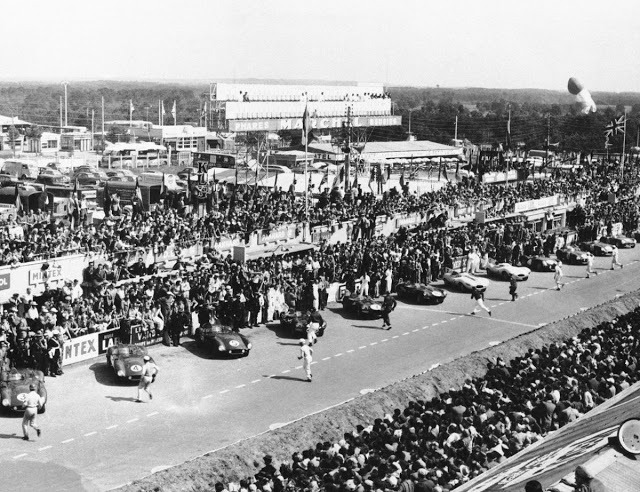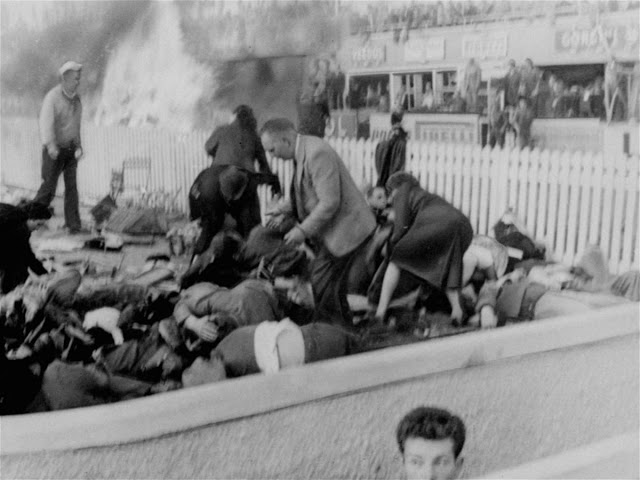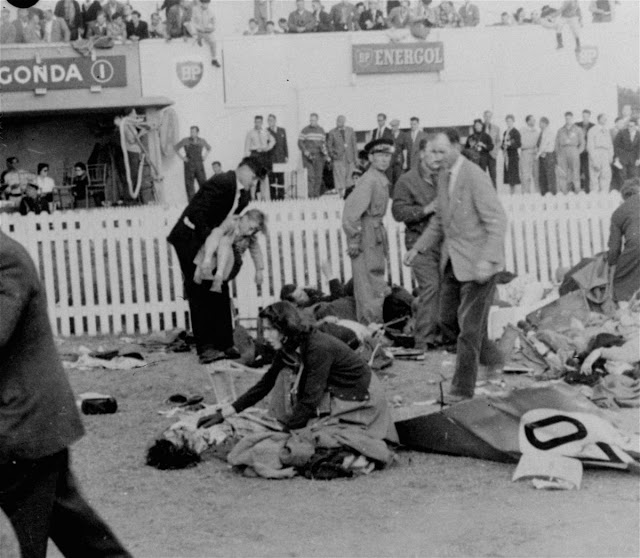
The 1955 Le Mans disaster occurred during the 24 Hours of Le Mans motor race at Circuit de la Sarthe in Le Mans, France on June 11, 1955. A major crash caused large fragments of debris to fly into the crowd, killing 83 spectators and French driver Pierre Bouillin (who raced under the name Pierre Levegh) and injuring nearly 180 more. It was the most catastrophic crash in motorsport history, and it prompted Mercedes-Benz to retire from motor racing until 1989.
The crash started when Jaguar driver Mike Hawthorn pulled to the right side of the track in front of Austin-Healey driver Lance Macklin and started braking for his pit stop. Macklin swerved out from behind the slowing Jaguar into the path of Levegh, who was passing on the left in his much faster Elektron magnesium-alloy bodied Mercedes-Benz 300 SLR. Levegh rear-ended Macklin at high speed, overriding Macklin’s car and launching his own car through the air. Levegh’s car skipped over a protective earthen berm at 200 km/h (125 mph) and made at least two impacts within the spectator area, the last of which caused it to disintegrate, throwing him onto the track where he was instantly killed, and sending large pieces of debris into the packed spectator area in front of the grandstand, including the engine block, front suspension, and hood. The rear of Levegh’s car landed on the berm and exploded into flames.
Jaguar driver Duncan Hamilton, watching from the pit wall, recalled, “The scene on the other side of the road was indescribable. The dead and dying were everywhere; the cries of pain, anguish, and despair screamed catastrophe. I stood as if in a dream, too horrified to even think.”
Mike Hawthorn and the Jaguar team kept racing. With the Mercedes-Benz team withdrawn and the Ferraris all broken, Jaguar’s main competition had gone. Hawthorn and Bueb won the race by an easy margin of five laps from Aston Martin. The weather had closed in on Sunday morning and there was no victory celebration. However, an inopportune press photograph showed Hawthorn smiling on the podium swigging from the victor’s bottle of champagne. The French magazine L’Auto-Journal published it with the sarcastic caption, “À votre santé, Monsieur Hawthorn!” (In English, “To your health (‘Cheers’), Mr. Hawthorn!”)
 |
| Mike Hawthorn celebrating the 1955 Le Mans victory despite causing the deadliest accident in history of racing. |
Accounts put the death toll at 80 to 84 (spectators plus Levegh), either by flying debris or from the fire, with a further 120 to 178 injured. Other observers estimated the toll to be much higher. A special mass was held in the morning in the Le Mans Cathedral for the first funerals of the victims.
The death toll led to an immediate temporary ban on motorsports in France, Spain, Switzerland, Germany, and other nations, until the racetracks could be brought to a higher safety standard. In the United States, the American Automobile Association (AAA) dissolved their Contest Board that had been the primary sanctioning body for motorsport in the U.S. (including the Indianapolis 500) since 1904. It decided that auto racing detracted from its primary goals, and the United States Automobile Club was formed to take over the race sanctioning and officiating.
Much recrimination was directed at Hawthorn, saying that he had suddenly cut in front of Macklin and slammed on the brakes near the entrance to the pits, forcing Macklin to take desperate evasive action into the path of Levegh. This became the semi-official pronouncement of the Mercedes-Benz team and Macklin’s story. The Jaguar team in turn questioned the fitness and competence of Macklin and Levegh as drivers. The first media accounts were wildly inaccurate, as shown by subsequent analysis of photographic evidence conducted by Road & Track editor (and 1955 second-place finisher) Paul Frère in 1975. Additional details emerged when the stills reviewed by Frère were converted to video form.
The media also speculated on the violent fire that engulfed the wreck, which intensified when fire marshals poured their water-based extinguishers on the flames. They suggested that Mercedes-Benz had tampered with the official fuel-supply with an explosive additive, but the intensity of the fire was due instead to the magnesium-alloy construction of the chassis. Neubauer got the French authorities to test residual fuel left in the wreck’s fuel injection and the result vindicated the company.
Opinions differed widely amongst the other drivers as to who was directly to blame for the crash, and such differences remain even today. Macklin claimed that Hawthorn’s move to the pits was sudden, causing an emergency that led him to swerve into Levegh’s path. Years later Fitch claimed, based on his own recollection and from what he heard from others, that Hawthorn had caused it. Norman Dewis ventured the opinions that Macklin’s move around Hawthorn was careless and that Levegh was not competent to meet the demands of driving at the speeds the 300SLR was capable of.
Both Jaguar and Mercedes-Benz issued official statements, mainly in self-defense against the accusations leveled against them and their drivers. Neubauer limited himself to suggesting improvements to the pit straight and making pit-stops safer.
Macklin, on reading Hawthorn’s 1958 autobiography, Challenge Me the Race, was embittered when he found that Hawthorn now disclaimed all responsibility for the crash without identifying who had caused it. With Levegh dead, Macklin presumed that Hawthorn’s implication was that he (Macklin) had been responsible, and he began a libel action. The action was still unresolved when Hawthorn was killed in a non-racing crash on the Guildford bypass in 1959, ironically while overtaking a Mercedes-Benz in his Jaguar.
The official government inquiry into the accident called officials, drivers, and team personnel to be questioned and give evidence. The wreckage was examined and tested and, finally, returned to Mercedes-Benz nearly 12 months after the catastrophe. In the end the enquiry ruled that no specific driver was responsible for the crash, and that it was merely a terrible racing incident. The death of the spectators was blamed on inadequate safety standards for the track design. Tony Rolt and other drivers had been raising concerns about the pit straight since 1953.






Leave a Reply